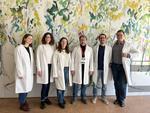Marco Ghibaudi
- SCIENZE VETERINARIE PER LA SALUTE ANIMALE E LA SICUREZZA ALIMENTARE
- Phd: 35th cycle
- Department of Veterinary Sciences
- Matriculation number: 768324
- ORCID: orcid.org/0000-0002-0296-8280

Contacts
- marco.ghibaudi@unito.it
- Neuroscience Institute Cavalieri Ottolenghi (NICO)
Regione Gonzole 10
10043 Orbassano (Torino) - https://dott-scivet.campusnet.unito.it/do/studenti.pl/Show?768324
- VCard contacts
- QRcode contacts
Supervisor
Luca BonfantiCurriculum vitae
Curriculum VitaePhd thesis
Summary
Most biomedical research, including the neurosciences, is largely carried out using laboratory rodents as animal models, yet differences are emerging with respect to humans. This fact can lead to an incorrect interpretation of preclinical data, and consequent problems in translation. In the last few years, remarkable interspecies differences have emerged in brain plasticity: the ability of the nervous tissue to modify its structure, allowing to refine cellular contacts and to “sculpt” neuronal circuits based on external/internal stimuli (both in physiological and pathological states). For this reason, studies in comparative neuroplasticity are needed, possibly performed in a “comparable” way.
Despite being substantially stable, the adult brain displays plasticity in different forms. A striking example is adult neurogenesis: the addition of new neurons from active division of neural stem cells, hosted in restricted “neurogenic niches”. Yet, neurogenic processes are heterogeneous in mammals, as to their types (canonical and non-canonical), and remarkable interspecies variation. In this complexity, a new form of plasticity is represented by populations of prenatally generated, “immature” or “dormant” neurons (INs): non-dividing cells that continue to express molecules of immaturity through life (some of which shared with the newlyborn neurons, such as the cytoskeletal protein doublecortin; DCX). The INs can “awake” at different time points by completing their maturation and functionally integrating into the preexisting circuitries (neurogenesis without division). Though restricted to paleocortex in rodents, the INs extend within the entire neocortex in other mammals, being particularly abundant in large-brained, gyrencephalic species. DCX+ cells are known to exist in subcortical regions, such as claustrum and amygdala, yet their nature (newly generated or dormant), as well as their interspecies variation, remain uncertain.
Here we pursued the mapping of the “immature” neuronal cell populations moving from the cortex to the subcortical regions of mammals (from mouse to chimpanzee). To obtain “comparable” results despite the high number of variables encountered (brain availability, brain size, tissue fixation, antibody specificity, real interspecies difference), we firstly set the best conditions for detecting our antigens of interest in widely different species. The study, carried out for DCX and Ki67-antigen in brain regions hosting INs (neocortex; paleocortex) and newlyborn neurons (hippocampus; subventricular zone), revealed that antibody species-specificity and real interspecies differences can be true limits, rather than different types of fixation.
On these bases, the occurrence, topographical distribution, and amount of DCX+ cells were investigated in the amygdala of 7 mammalian species at different ages. The analysis was extended to cell division (Ki67 antigen), in search for possible marker coexpression. While the DCX+ cells were more abundant in the amygdala of non-rodent species (especially in primates), the dividing cells showed an inverse pattern. Coexpression of the two antigens was never found, and the two cell populations displayed very different topographical distribution in all the species investigated. These results strongly indicate that the amygdalar DCX+ cells are INs with high interspecies variation, being particularly important in complex brains of long-living species. Interestingly, their amount remained substantially unchanged between young and aged individuals, suggesting that they may persist as a reservoir of undifferentiated neurons in the adult/aging amygdala. This raised the question whether INs of the cortex behave similarly through the animal lifespan. Hence, the variation in number and features of cINs was investigated in the mouse paleocortex at different ages (from 1 to 15 months). We found a marked decrease in cINs during juvenile stages, reminiscent of that observed for hippocampal neurogenesis, and only a small amount of cINs persisted up to advanced ages. Results obtained in the mouse cortex where very different from what observed in the amygdala (and cortex) of gyrencephalic species: while reaching a slow exhaustion in short-living species, the INs form a long-lasting reservoir of “plastic” cells in long-living mammals.
Overall, a new landscape emerges, likely sculpted by evolution: INs represent the prevalent choice in gyrencephalic, long-living species, not only being more abundant but diluted in time to grant a reservoir of plastic neurons in strategic brain regions.
Research activities
Attended Congresses
BraYn (2nd Brainstorming Research Assembly for Young Neuroscientist) - November 14th-15th-16th 2019
GISN (Gruppo Italiano per lo Studio della Neuromorfologia) - November 12th-13th-14th 2020
ENCODES (European Neuroscience Conference by Doctoral Students) - June 4th-5th-6th 2021
SINS (Italian Society for Neuroscience) - September 9th-10th-11th 2021
GISN (Gruppo Italiano per lo Studio della Neuromorfologia) - November 26th-27th 2021
Game of Research - North Edition - December 16th 2021
Publications
Ghibaudi M, Marchetti N, Vergnano E, La Rosa C, Benedetti B, Couillard-Despres S, Farioli-Vecchioli S, Bonfanti L. (2023) Age-related changes in layer II immature neurons of the murine piriform cortex. Front. Cell. Neurosci. 17:1205173; doi: 10.3389/fncel.2023.1205173
Ghibaudi M, Amenta A, Agosti M, Riva M, Graïc J.-M, Bifari F, Bonfanti L. (2023) Consistency and variation in doublecortin and Ki67 antigen detection in the brain tissue of different mammals, including humans. Int. J. Mol. Sci. 24(3), 2514; doi: 10.3389/fncel.2023.1205173.
Ghibaudi M., Bonfanti L. (2022) How widespread are the "Young" neurons of the mammalian brain? Front Neurosci16:918616. doi: 10.3389/fnins.2022.918616
La Rosa C., Ghibaudi M., Bonfanti L. (2019) Newly Generated and Non-Newly Generated “Immature” Neurons in the Mammalian Brain: A Possible Reservoir of Young Cells to Prevent Brain Aging and Disease? J Clin Med 15;8(5):685. doi: 10.3390/jcm8050685
Awards
Premio "Mariella Graffi" 2023 per tesi magistrale in temi di Anatomia Comparata (Accademia dei Lincei)
2nd place for best presentation at Game of Research - North Edition (DSV, University of Turin)




